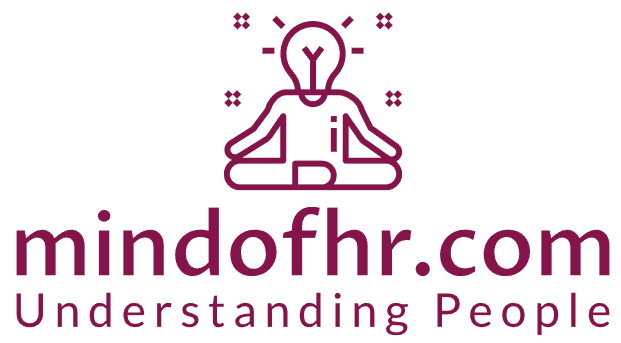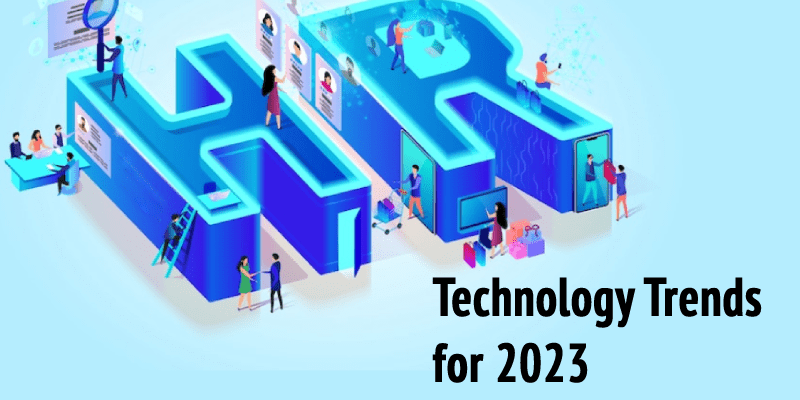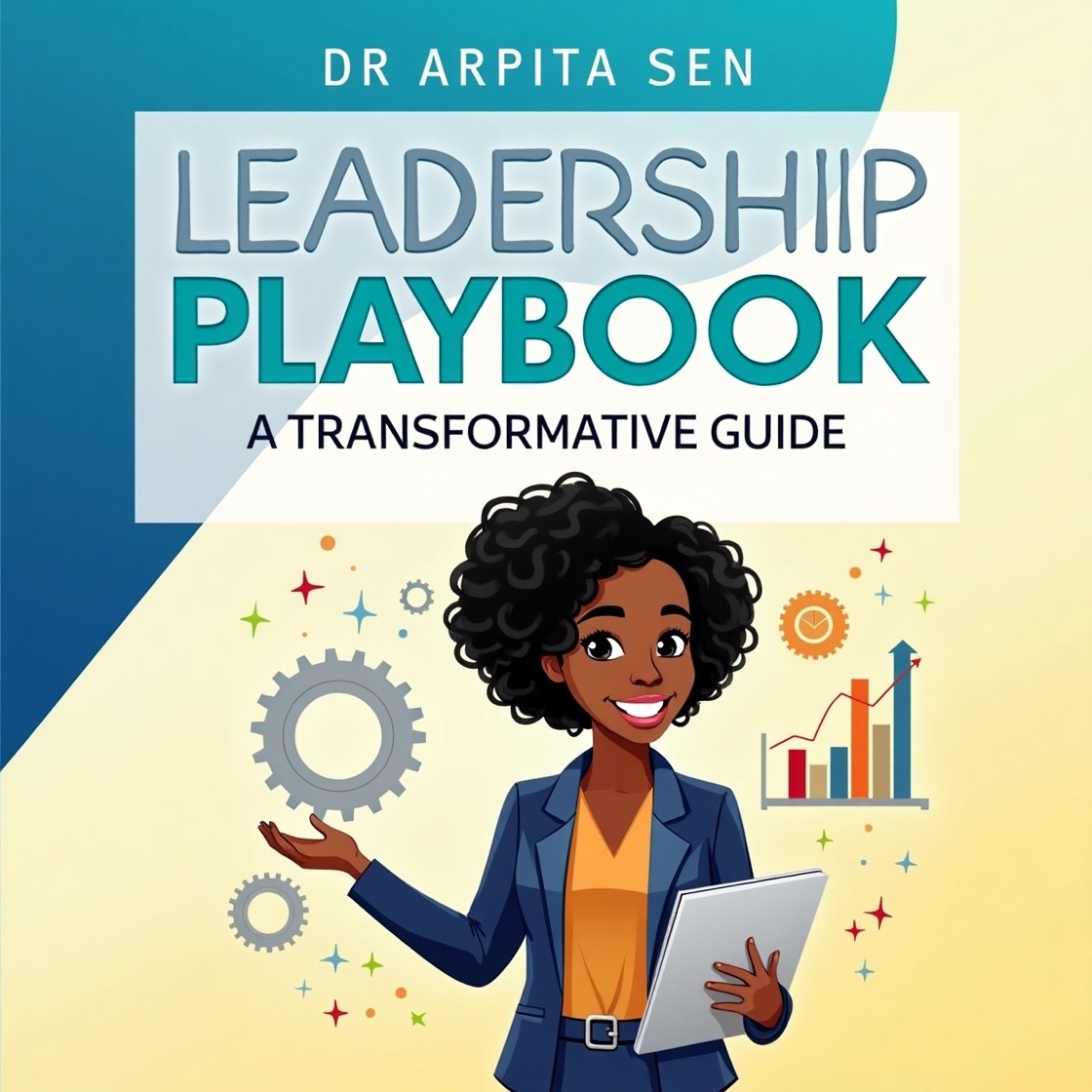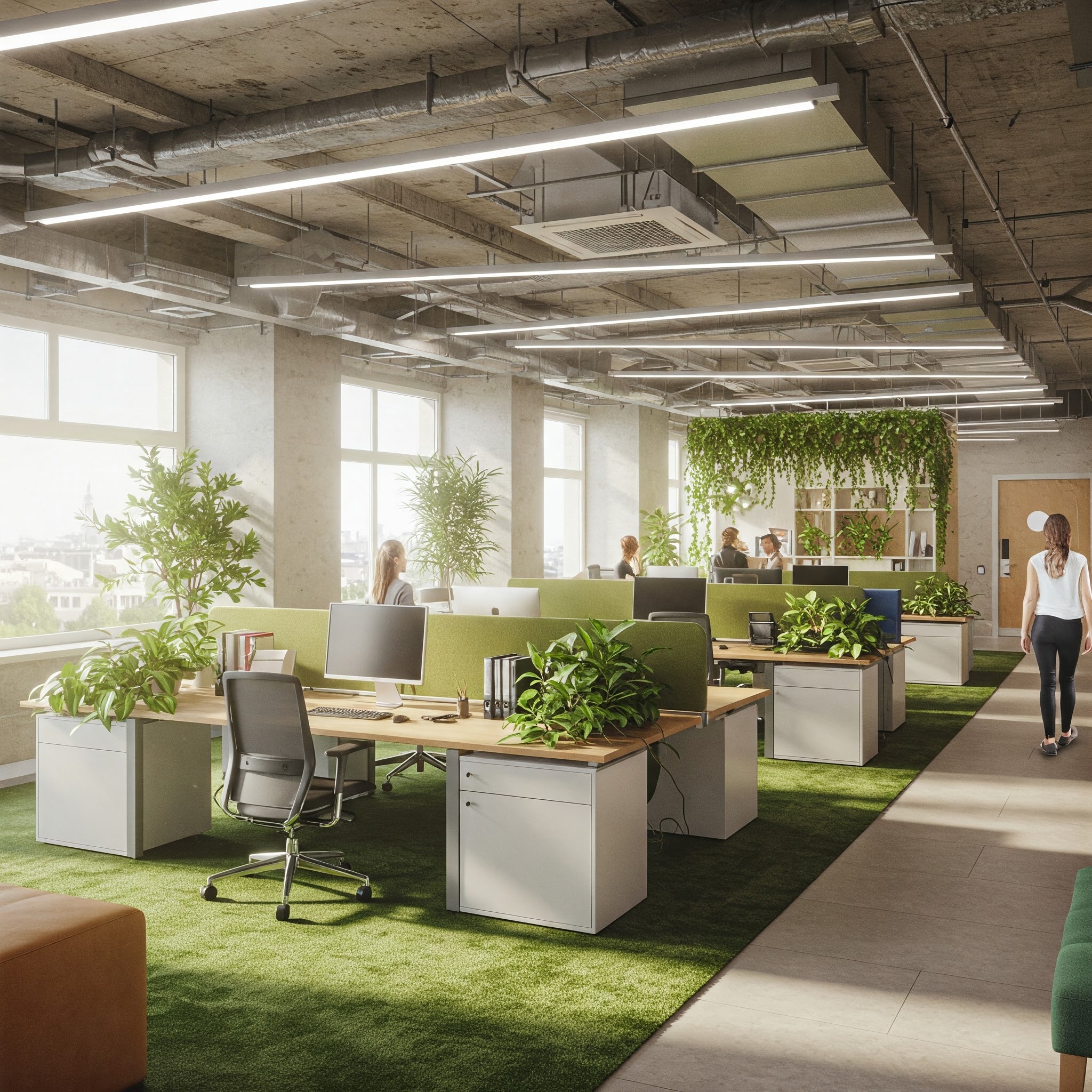As the curtains fell on 2023, a year that witnessed a quantum leap in the realm of work, the metamorphosis from the shadows of 2019 to 2022 unveiled not just improvement but an intricate dance with challenges. Corporations found themselves at the crossroads, torn between the echoes of recalling employees to the office and the intricate dance of navigating hybrid work models. Simultaneously, the workforce grappled with uncertainties, attempting to weave trust in the fabric of organizations amid the backdrop of sporadic layoffs.
Within the crucible of these challenges, 2023 birthed a myriad of groundbreaking technologies that not only alleviated workflows but also sculpted a new narrative of workplace efficiency.
1. Pinnacle of Professional Development and Upskilling: A Symphony of Growth
The canvas of professional development and upskilling transformed from sporadic training events to becoming integral components of the employee experience. In 2023, companies nurtured a culture of perpetual learning, encouraging employees to embark on journeys of acquiring new skills and knowledge. This transformation was propelled by the relentless pace of technological advancements, urging employees to stay on the cutting edge of relevance in their roles. Companies championing these initiatives not only fortified the skillsets of their workforce but also cultivated a culture of innovation and adaptability that resonated throughout the year.
Technology Sector: The Sonic Boom of Adaptability
In the dynamic realm of technology, where innovation is the heartbeat, companies spearheaded the charge in fostering a culture of perpetual learning. Tech giants, such as Google and Microsoft, curated bespoke learning platforms, offering a vast array of courses to their employees. These platforms became virtual academies, propelling software engineers, data scientists, and IT professionals into immersive learning experiences that kept them abreast of cutting-edge developments. This initiative not only fortified the skillsets of the workforce but also nurtured an environment of innovation and adaptability, ensuring that employees remained at the forefront of technological advancements.
Healthcare Landscape: Healing Through Knowledge
The healthcare industry, a bastion of constant evolution, embraced a symphony of growth by prioritizing professional development and upskilling. Pharmaceutical companies invested in specialized training programs for their research and development teams, ensuring they were well-versed in the latest medical breakthroughs and technologies. This proactive approach not only elevated the skills of healthcare professionals but also had a profound impact on patient care. Nurses, doctors, and medical staff, equipped with updated knowledge, delivered healthcare services that reflected the pinnacle of expertise.
Financial Services: Navigating the Symphony of FinTech
In the financial services sector, marked by the transformative waves of FinTech, companies orchestrated a crescendo in professional development to navigate the intricate landscape. Banking institutions, such as JPMorgan Chase and Goldman Sachs, established FinTech academies to empower their employees with skills in blockchain technology, artificial intelligence, and cybersecurity. This strategic investment not only fortified the workforce against emerging threats but also positioned these institutions as leaders in the financial technology revolution.
Manufacturing Marvels: Crafting a Symphony of Innovation
The manufacturing sector, traditionally rooted in precision and efficiency, witnessed a symphony of growth through professional development initiatives. Industry giants like Toyota and Siemens implemented comprehensive upskilling programs, enabling their workforce to leverage the latest advancements in automation, robotics, and artificial intelligence. This not only streamlined production processes but also fueled a culture of innovation, where employees became architects of efficiency in the manufacturing landscape.
Creative Industries: Nurturing the Artistic Crescendo
Even in the realms of creativity and design, professional development took center stage. Media and entertainment companies like Disney and Netflix invested in programs that enhanced the skills of their creative teams. Animators, writers, and designers engaged in continuous learning, exploring new storytelling techniques, animation technologies, and creative tools. This not only enriched the creative output but also positioned these companies at the forefront of artistic innovation in the ever-evolving entertainment landscape.
In the kaleidoscope of industries, the symphony of professional development and upskilling in 2023 was not a monotonous tune but a dynamic and diverse melody, resonating with the unique cadence of each sector. This transformative journey not only fortified the workforce but also elevated industries to new heights of innovation and excellence. The investment in continuous learning became not just a corporate strategy but a testament to the resilience and adaptability that defined the spirit of each industry in the tapestry of 2023.
2. The Resplendent Rise of the Culture of High Productivity
A resounding trend that echoed through the corridors of work in 2023 was the establishment of a culture of high productivity. This trend underscored efficiency, collaboration, a results-oriented mindset, and a proactive approach to achieving goals. The vibrancy of this culture was painted with brushstrokes of goal-setting, seamless technology integration, continuous communication, a tapestry of recognition and rewards, well-defined processes, regular feedback, and a symphony of performance reviews.
Technology Titans: Efficiency as the Code
Within the technological realm, giants like Apple and Amazon set the stage for a culture of high productivity by embedding efficiency into their organizational DNA. Agile methodologies became the linchpin, guiding software development teams toward rapid and iterative progress. Seamless technology integration became a hallmark, with the adoption of cutting-edge project management tools and collaboration platforms. This not only streamlined workflows but also fostered a culture where innovation and efficiency were not merely goals but woven into the fabric of daily operations.
Healthcare Harmony: Precision in Patient Care
In the healthcare sector, where precision is paramount, the culture of high productivity took center stage. Hospitals and healthcare providers, such as Mayo Clinic and Kaiser Permanente, emphasized well-defined processes and continuous communication to enhance patient care. Technology integration manifested in electronic health records, ensuring seamless information flow between medical professionals. Regular performance reviews and feedback loops became instrumental in refining healthcare delivery, creating an environment where every aspect of the organization resonated with a commitment to productivity in the service of patient well-being.
Financial Fortitude: Results-Driven Financial Services
Financial institutions, including Morgan Stanley and Bank of America, orchestrated a symphony of high productivity in the pursuit of financial excellence. Goal-setting became a guiding principle, with teams aligning their efforts to overarching financial targets. Recognizing and rewarding achievements became not just a practice but a celebration of milestones, fostering a results-oriented mindset. Continuous communication through advanced financial technology platforms ensured that teams were synchronized in real-time, contributing to the seamless execution of financial strategies.
Manufacturing Mastery: Streamlining Efficiency on the Factory Floor
In the manufacturing domain, where precision and speed intertwine, companies like General Electric and Toyota epitomized the culture of high productivity. Well-defined processes on the factory floor, powered by automation and robotics, streamlined production. Goal-setting permeated every level, from individual workstations to overarching production targets. Continuous feedback loops, facilitated by IoT (Internet of Things) technology, allowed for real-time adjustments, ensuring that efficiency was not just a goal but an ongoing journey toward manufacturing mastery.
Creative Crescendo: Efficiency in Artistry
Even in the world of creativity and design, the culture of high productivity left its indelible mark. Media and entertainment conglomerates such as Warner Bros. and Pixar embraced well-defined creative processes that facilitated collaboration among diverse teams. Technology integration, including advanced animation and design tools, fueled a vibrant and efficient creative process. Regular feedback sessions and performance reviews became a means to elevate artistic output, ensuring that the intersection of creativity and productivity was not just a challenge but a harmonious collaboration.
In the grand symphony of industries, the culture of high productivity in 2023 was not a uniform rhythm but a multifaceted melody, adapting to the nuances of each sector. It was a masterpiece painted with strokes of efficiency, collaboration, and a results-oriented mindset, showcasing how organizations across diverse fields embraced a proactive approach to achieve their goals. The resonating echo of this culture reverberated through the professional landscape, leaving an enduring mark on the year 2023.
3. Hybrid Work: The Uncharted Expedition
In the tapestry of 2023, a noticeable shift towards hybrid working emerged, departing from the complete remote work setup that dominated the Covid era. Companies adopted an intriguing approach by offering 2-3 days of remote work to retain talent and adapt to the post-pandemic landscape. However, a divergence from this trend was witnessed, with some organizations favoring an office-centric approach for enhanced coordination and productivity.
Technology Trailblazers: Remote Innovation and Collaborative Hubs
In the realm of technology, where innovation thrives, hybrid work became a strategic choice for companies like Microsoft and Salesforce. These tech trailblazers recognized the importance of remote work for fostering individual creativity and innovation. Simultaneously, they invested in collaborative hubs, physical spaces designed for teamwork and brainstorming, where employees converged for intensive collaboration. This approach not only retained top talent but also provided a physical nexus for synergies that remote work alone couldn’t replicate.
Healthcare Harmony: Flexibility in Healing
Healthcare institutions, such as the Cleveland Clinic and Johns Hopkins Medicine, undertook the hybrid work expedition with a focus on flexibility in healing. While patient-facing roles remained anchored in healthcare facilities, administrative and non-clinical functions embraced remote work. This flexibility allowed healthcare professionals to strike a balance between in-person care and administrative responsibilities, ensuring a resilient and adaptive workforce ready to meet the diverse needs of patients.
Financial Frontiers: Balancing Security and Agility
In the financial sector, where security is paramount, hybrid work was embraced as a delicate dance between retaining top-tier talent and safeguarding sensitive information. Institutions like JPMorgan Chase and Goldman Sachs introduced robust hybrid work models. Critical functions requiring heightened security remained in-office, while roles conducive to remote work were granted flexibility. This approach ensured that the financial industry maintained its reputation for confidentiality and compliance while adapting to the changing expectations of a modern workforce.
Manufacturing Mosaic: Remote Operations and On-Site Precision
Within the manufacturing landscape, characterized by precision and teamwork, hybrid work took on a unique hue. Companies like Siemens and Boeing embraced remote operations for roles amenable to virtual collaboration, such as design and planning. Simultaneously, on-site teams maintained a presence for tasks requiring hands-on precision. This hybrid approach not only optimized efficiency but also allowed for the seamless integration of remote and on-site expertise, creating a mosaic of productivity.
Creative Confluence: Nurturing Artistic Synergy
In the creative industries, where collaboration fuels innovation, hybrid work emerged as a conduit for artistic synergy. Companies like Disney and Warner Bros. maintained creative hubs where teams could gather periodically for ideation and collaboration. Remote work, on the other hand, provided individual creatives with the autonomy to nurture their artistic process. This delicate balance fostered a dynamic creative environment, ensuring that the magic of collaboration continued to thrive while embracing the flexibility of remote work.
In the grand expedition of industries, hybrid work in 2023 wasn’t a one-size-fits-all approach but a nuanced exploration, adapting to the unique contours of each sector. It was an uncharted journey, where companies navigated the delicate balance between remote and office-based work, seeking to create a work environment that harmonized flexibility, innovation, and productivity. The legacy of this expedition would ripple through the professional landscape, influencing how organizations approached the intersection of virtual and physical workspaces.
4. Work-Life Alchemy: Crafting a Holistic Balance
Companies were compelled to address the evolving concept of traditional work-life balance by embracing a more holistic outlook towards work-life management. Innovative benefits such as floater leaves for birthdays and anniversaries became the brushstrokes that contributed to a happier employee experience. This proactive approach not only reflected a commitment to employee well-being but also played a pivotal role in fostering a content and satisfied workforce.
Technology Titans: Nurturing Well-being in the Digital Age
Technology juggernauts, such as Google and Facebook, spearheaded the alchemical transformation of work-life dynamics. In recognition of the digital age’s demands, these companies introduced innovative benefits that transcended conventional norms. Beyond flexible working hours, employees enjoyed tailored wellness programs, mental health resources, and a unique blend of remote and collaborative office spaces. The introduction of “unplugged” days, where employees were encouraged to disconnect from work emails and calls, became a potent elixir for maintaining a healthy work-life equilibrium.
Healthcare Harmonies: Balancing Care for Both Patients and Professionals
Within the healthcare sector, where the dedication to patient care often intertwines with demanding schedules, institutions like Mayo Clinic and Cleveland Clinic embraced work-life alchemy as a vital aspect of employee well-being. Flexible scheduling for medical professionals, coupled with initiatives like wellness retreats and mindfulness programs, became integral to maintaining a harmonious balance between the demanding nature of healthcare work and personal rejuvenation. This approach not only enhanced job satisfaction but also contributed to a workforce better equipped to deliver quality care.
Financial Flourish: Investment in Employee Fulfillment
Financial institutions, including Morgan Stanley and Charles Schwab, redefined work-life alchemy by investing in employee fulfillment beyond financial gains. In addition to competitive compensation, employees were offered sabbaticals for personal development, financial wellness programs, and family-friendly policies. The introduction of personalized benefits, such as milestone bonuses for work anniversaries and milestone life events, served as a testament to the commitment to the holistic well-being of their workforce.
Manufacturing Mosaic: Nurturing a Culture of Well-being
In the manufacturing sector, renowned for its precision and efficiency, companies like Toyota and General Electric embarked on a journey to nurture a culture of well-being. Beyond optimizing production processes, these organizations introduced initiatives such as four-day work weeks, fostering a balance between work commitments and personal time. Wellness challenges, team-building retreats, and creative spaces within the workplace became the cornerstones of a holistic approach to work-life management.
Creative Constellations: Inspiring Innovation Through Balance
In the realm of creativity and design, where inspiration is paramount, companies like Pixar and Adobe championed work-life alchemy to inspire innovation. Creative sabbaticals, where employees were encouraged to take extended breaks for self-discovery, and dedicated time for personal projects fueled a culture that acknowledged the profound connection between personal fulfillment and professional creativity. The introduction of “creative wellness” days allowed employees to explore diverse sources of inspiration, ensuring that the creative process was not only productive but also fulfilling.
In the grand tapestry of industries, work-life alchemy in 2023 became a living, breathing philosophy, transcending the boundaries of traditional work-life balance. It was a testament to the acknowledgment that employee well-being is not merely a checkbox but a dynamic interplay between professional commitment and personal fulfillment. As organizations continued to craft this holistic harmony, the ripple effect echoed through content and satisfied workforces, leaving an indelible mark on the evolving narrative of the modern workplace.
5. Green and Sustainable Revolution: Stewards of the Future
Environmental consciousness assumed center stage for businesses in 2023, as sustainable practices seamlessly interwove into corporate strategies. Companies, cognizant of their role in contributing to a greener future, actively aligned with socially responsible practices. Initiatives spanning from eco-friendly operations to sustainable supply chain management were the cornerstone of reducing environmental footprints. Sustainability emerged as a sought-after topic, epitomizing a collective effort towards responsible and environmentally conscious business practices.
Technology Trailblazers: Silicon Valley’s Eco-Innovation Odyssey
In Silicon Valley, where innovation reigns supreme, technology giants such as Tesla and Apple spearheaded an eco-innovation odyssey. These trailblazers not only adopted sustainable practices within their operations but also pioneered groundbreaking solutions for a greener future. Initiatives like carbon-neutral data centers, renewable energy-powered campuses, and the integration of sustainable materials in product design became benchmarks for the industry. The commitment to reducing electronic waste and embracing circular economy principles showcased how technology could lead the charge in fostering a sustainable revolution.
Healthcare Harmony: Preserving Health, Preserving the Planet
The healthcare sector, with its commitment to healing, found resonance in the ethos of preserving both health and the planet. Mayo Clinic and Kaiser Permanente took strides toward sustainability by incorporating eco-friendly practices within their facilities. From energy-efficient medical equipment to green building certifications, these healthcare institutions demonstrated that prioritizing environmental well-being was not just a corporate initiative but an essential element of ensuring the health and well-being of communities they serve.
Financial Forefront: Investing in a Sustainable Tomorrow
Financial institutions, including BlackRock and Barclays, leveraged their influence to shape a sustainable future. Beyond financial portfolios, these institutions integrated environmental, social, and governance (ESG) criteria into their investment strategies. Financing green initiatives, supporting sustainable businesses, and fostering transparency in reporting sustainability metrics became pivotal in aligning financial growth with environmental responsibility. The financial sector’s commitment to sustainability underscored the understanding that economic prosperity and ecological health are interdependent.
Manufacturing Mastery: Crafting a Sustainable Blueprint
In the manufacturing realm, renowned for its impact on the environment, companies like Unilever and Toyota crafted a sustainable blueprint. Eco-friendly packaging, zero-waste manufacturing processes, and commitment to renewable energy were integral elements. Beyond reducing their own environmental footprint, these manufacturing giants extended their influence across supply chains, collaborating with suppliers to adhere to sustainable practices. This approach transformed sustainability from a corporate buzzword to a tangible commitment woven into the fabric of manufacturing processes.
Creative Confluence: Artistic Expression with Environmental Responsibility
In the creative industries, where imagination meets innovation, companies like Patagonia and Netflix embraced artistic expression with a profound sense of environmental responsibility. Eco-conscious content production, sustainable set designs, and responsible waste management during filming became the norm. These companies not only entertained audiences but also inspired a collective sense of responsibility, illustrating that creativity could thrive in harmony with environmental stewardship.
In the symphony of industries, the green and sustainable revolution of 2023 wasn’t a fleeting trend but a dynamic commitment to being stewards of the future. It showcased that businesses, regardless of their sector, could contribute meaningfully to environmental well-being while achieving economic success. The collective effort towards responsible and environmentally conscious practices became a hallmark of the modern business landscape, echoing a resounding call to preserve and protect the planet for generations to come.
6. The Odyssey of the Non-Traditional Workforce
The pursuit of a non-traditional workforce became a compelling saga as companies embraced a paradigm shift in talent acquisition and workforce diversity. This trend represented a departure from conventional hiring norms, accentuating flexibility, encouraging innovation, amplifying problem-solving capabilities, and recognizing that valuable skills and perspectives can emanate from diverse sources.
Technology Titans: Embracing Diversity in the Silicon Valley Spectrum
Within the dynamic landscape of technology, companies like Intel and Adobe embraced the odyssey of the non-traditional workforce with open arms. This meant moving beyond the traditional tech talent pool and recognizing the value of hiring individuals with unconventional career paths. Hackathons and coding bootcamps became gateways for discovering hidden talents, while initiatives to hire neurodivergent individuals highlighted the commitment to diversity and innovation. The technology sector’s embrace of a non-traditional workforce reflected an understanding that creativity and breakthroughs often arise from diverse backgrounds and experiences.
Healthcare Harmony: Diverse Perspectives in Patient Care
In the healthcare sector, where empathy and diverse perspectives are paramount, institutions like Cleveland Clinic and Johns Hopkins Medicine championed the odyssey of a non-traditional workforce. This involved recruiting individuals from diverse cultural backgrounds and fostering an inclusive environment for healthcare professionals with non-traditional career trajectories. The commitment to diversity not only enriched the patient experience but also contributed to a more comprehensive understanding of healthcare challenges and solutions.
Financial Frontiers: Innovation Through a Diverse Lens
Financial institutions, including Goldman Sachs and Citigroup, embarked on an odyssey of the non-traditional workforce to infuse innovation into their ranks. Beyond traditional finance backgrounds, these institutions actively sought individuals with expertise in fields such as data science, psychology, and design. Embracing diversity in thought and skillsets became a strategic advantage, enabling financial organizations to adapt to the rapidly evolving landscape and offer innovative solutions to their clients.
Manufacturing Mosaic: Creative Problem-Solving on the Factory Floor
In the manufacturing realm, where precision and efficiency reign, companies like General Motors and Siemens undertook the odyssey of a non-traditional workforce to enhance problem-solving capabilities. This involved recruiting individuals with backgrounds in design thinking, art, and even gaming. The infusion of diverse perspectives led to creative solutions on the factory floor, optimizing processes, and fostering a culture of continuous improvement.
Creative Constellations: Diverse Voices in Artistic Expression
In the world of creativity and design, companies such as Pixar and Spotify championed the odyssey of the non-traditional workforce, recognizing that artistic expression flourishes with diverse voices. This involved hiring creatives from unconventional backgrounds, including individuals with a deep passion for storytelling or unique perspectives gained from non-traditional art forms. The result was a mosaic of creativity that resonated with audiences globally, showcasing the power of diverse perspectives in shaping artistic innovation.
The odyssey of the non-traditional workforce in 2023 was not just a trend but a dynamic evolution, illustrating that the pursuit of talent transcends traditional boundaries. Across industries, companies discovered the value of diverse perspectives, recognizing that unconventional paths often lead to groundbreaking solutions and unparalleled creativity. This odyssey became a testament to the adaptability and forward-thinking nature of organizations that dared to redefine the conventional and embrace the richness of diversity.
7. The Embrace of AI and Automation: Symphony of Efficiency
Amidst the ever-evolving business landscape, companies wholeheartedly embraced AI and automation to amplify efficiency in the workplace. In 2023, AI was a ubiquitous force, permeating domains such as content development, marketing, customer service, product development, and beyond. This marked a significant shift in the operational paradigm, redefining the very essence of how businesses function.
Technology Titans: AI’s Prowess in Silicon Valleys Laboratories
In the heart of technological innovation, companies like Google and Amazon spearheaded the embrace of AI and automation, showcasing the prowess of these technologies in Silicon Valley’s laboratories. AI algorithms became the backbone of search engines, optimizing results and personalizing user experiences. Automation streamlined logistics and supply chain processes, ensuring swift deliveries and efficient inventory management. These technological titans, by integrating AI seamlessly into their operations, set the stage for the broader technological landscape, illustrating the potential for increased efficiency in diverse business functions.
Healthcare Harmony: Precision Medicine and Automated Patient Care
Within the healthcare sector, institutions such as Mayo Clinic and GE Healthcare harnessed AI’s potential to revolutionize patient care. Precision medicine, empowered by AI algorithms, tailored treatments to individual genetic profiles. Automated diagnostic tools enhanced accuracy and speed in identifying medical conditions. The embrace of AI not only elevated the efficiency of healthcare delivery but also paved the way for more personalized and effective medical interventions.
Financial Fortitude: AI-Driven Analytics and Automated Transactions
In the financial sector, characterized by data complexity and real-time transactions, companies like JPMorgan Chase and Vanguard embraced AI and automation. AI-driven analytics offered insights into market trends and customer behaviors, informing strategic investment decisions. Automated transactions and fraud detection systems streamlined financial processes, ensuring security and efficiency in a rapidly changing economic landscape. The integration of AI became synonymous with financial fortitude, enabling institutions to navigate complex markets with agility and precision.
Manufacturing Marvels: Smart Factories and Autonomous Processes
In the manufacturing realm, giants like Siemens and Toyota transformed their operations into smart factories, where AI and automation orchestrated a dance of efficiency. Predictive maintenance, powered by AI, reduced downtime by foreseeing equipment failures before they occurred. Autonomous processes, guided by automation, optimized production lines, ensuring a seamless and precise manufacturing process. The embrace of AI and automation in manufacturing not only increased efficiency but also heralded a new era of innovation and sustainability.
Creative Confluence: AI-Enhanced Content Creation and Innovative Designs
Even in the realm of creativity and design, companies like Adobe and Netflix embraced AI to enhance content creation and design processes. AI algorithms analyzed user preferences to suggest personalized content, revolutionizing the entertainment landscape. Automated design tools enabled creatives to experiment with innovative ideas, pushing the boundaries of artistic expression. The creative confluence of human ingenuity and AI-driven tools became a testament to the collaborative potential of these technologies.
In the symphony of industries, the embrace of AI and automation in 2023 was not just a technological shift but a transformative journey toward unparalleled efficiency. Companies across diverse sectors acknowledged the potential of these technologies to revolutionize their operations, optimize processes, and elevate their competitive edge. The symphony of efficiency orchestrated by AI and automation became the defining soundtrack of a year where businesses embraced the future with open arms.
8. Gig Economy and Freelancing: The Liberation of Work
The gig economy blossomed as an increasing number of individuals embraced freelance and contract work over traditional employment. This seismic shift in the employment landscape necessitated organizations to reevaluate their strategies for talent acquisition and management. Platforms facilitating connections between freelancers and opportunities experienced a surge in popularity, playing a pivotal role in the continuous evolution of traditional employment models.
Technology Transformation: Digital Platforms Redefining Employment
At the forefront of the gig economy’s blossoming were digital platforms, exemplified by companies like Upwork and Fiverr, redefining the very nature of employment. Freelancers and businesses found a common ground on these platforms, transcending geographical constraints and traditional hiring barriers. The seamless matchmaking between skills and projects became a testament to the transformative power of technology in reshaping the employment landscape. This shift wasn’t just about jobs; it was about creating a dynamic and flexible ecosystem where individuals could leverage their skills on a global scale.
Healthcare Harmony: Specialized Freelance Roles in Patient-Centric Care
In the healthcare sector, where patient-centric care is paramount, the gig economy unfolded as a catalyst for specialized freelance roles. Medical professionals, from specialized consultants to telemedicine specialists, found avenues to contribute their expertise beyond traditional hospital structures. Healthcare institutions, including telehealth startups and established medical centers, tapped into this pool of freelance talent to enhance patient care, demonstrating the adaptability of the gig economy in meeting evolving industry needs.
Financial Flexibility: Freelance Finance Experts Reshaping Strategies
In the financial sector, marked by dynamic market shifts, freelance finance experts played a pivotal role in reshaping strategies. Fintech startups and established institutions alike leveraged the gig economy to access specialized skills in areas such as risk management, blockchain technology, and financial analysis. The flexibility afforded by freelance engagements allowed financial organizations to adapt swiftly to market changes, fostering a culture of innovation and expertise diversification.
Manufacturing Metamorphosis: Agile Freelancers in the Production Line
Within manufacturing, known for its precision and efficiency, agile freelancers became integral to the production line. Companies like General Electric and BMW tapped into specialized freelance talent for short-term projects, from designing innovative components to streamlining logistics processes. The gig economy’s influence in manufacturing went beyond cost efficiency; it became a catalyst for injecting fresh perspectives and innovation into established production methodologies.
Creative Canvas: Freelance Creatives Redefining Artistic Expression
In the realm of creativity and design, freelancers emerged as the architects of innovation. Media companies like Disney and Netflix embraced freelance creatives for diverse projects, from graphic design to content creation. The gig economy not only provided creative professionals with the freedom to explore varied projects but also enabled companies to tap into a global pool of artistic talent, fostering a rich and diverse creative landscape.
In the grand symphony of industries, the gig economy and freelancing in 2023 were not just alternative work arrangements but the liberation of work itself. It reshaped traditional employment paradigms, offering individuals the autonomy to define their careers and organizations the agility to tap into a dynamic pool of talent. This ongoing evolution marked a shift from the rigidity of traditional employment to a flexible and collaborative future where the liberation of work was not just a trend but a fundamental transformation in how we perceive and engage in employment.
9. The Symphony of Employee Well-being
In the grand symphony of 2023, organizations conducted a harmonic shift towards a people-centric approach, placing paramount importance on employee well-being. Crafting a workplace that nurtures not only professional growth but also personal fulfillment emerged as a cornerstone in cultivating a resilient and high-performing workforce. Leaders’ commitment to championing initiatives that enable employees to thrive both professionally and personally became a resonant melody, defining the year.
Technology Tenor: Wellness in the Silicon Valley Workspace
In the bustling Silicon Valley, technology giants such as Apple and Google took center stage in orchestrating the symphony of employee well-being. Beyond competitive salaries, these companies invested heavily in on-site wellness facilities, mental health resources, and initiatives that fostered work-life balance. Flexible schedules and remote work options became integral notes in the melody of employee well-being, creating an environment where technology professionals could thrive not just in their careers but also in their personal lives.
Healthcare Harmony: Nurturing Well-being in Healing Institutions
Within the healthcare sector, where the commitment to well-being is inherent, institutions like Mayo Clinic and Cleveland Clinic fine-tuned the symphony of employee well-being. Employee assistance programs, mental health support, and wellness retreats became instrumental in ensuring that healthcare professionals were not only equipped to provide quality patient care but were also supported in their own well-being. This approach not only enhanced job satisfaction but also contributed to a workforce that could navigate the demanding landscape of healthcare with resilience.
Financial Flourish: Cultivating Prosperity in Employee Well-being
In the financial sector, characterized by high-pressure environments, companies like Morgan Stanley and JPMorgan Chase conducted a harmonious symphony of employee well-being. Beyond traditional benefits, financial organizations introduced financial wellness programs, personalized benefits, and initiatives that fostered a sense of financial security. Sabbaticals for personal development and family-friendly policies were instrumental notes in creating an environment where financial professionals could flourish not only in their careers but also in their personal lives.
Manufacturing Melody: Wellness on the Factory Floor
In the manufacturing realm, renowned for its precision and efficiency, companies like Toyota and General Electric introduced wellness programs on the factory floor. Ergonomic initiatives, mental health resources, and fitness programs became integral components of the symphony of employee well-being. The acknowledgment that well-supported employees are more likely to contribute to a safer and more efficient production environment became a guiding principle in manufacturing’s evolving approach to employee welfare.
Creative Crescendo: Thriving in Artistic Workplaces
In the world of creativity and design, media and entertainment conglomerates like Pixar and Warner Bros. composed a creative crescendo in the symphony of employee well-being. Beyond traditional perks, creative industries introduced initiatives such as sabbaticals for artistic exploration, creative wellness days, and collaborative spaces that fueled inspiration. This approach not only nurtured artistic expression but also cultivated a workplace where creative professionals could thrive emotionally and professionally.
In the symphony of industries, the focus on employee well-being in 2023 was not a mere note but a resonant melody, defining the workplace culture of the future. As organizations embraced the people-centric approach, they not only cultivated a workforce that excelled in their professional roles but also crafted an environment where employees could lead fulfilling lives beyond the confines of their jobs. The symphony of employee well-being became a transformative force, echoing the understanding that an organization’s success is intrinsically tied to the well-being and flourishing of its people.
What’s next in 2024?
As the curtain draws on the dynamic stage of HR trends in 2023, it leaves behind a legacy of transformative shifts that reshaped the landscape of work and employment. The year saw organizations embracing a symphony of change, from the embrace of AI to the liberation of work in the gig economy and the harmonious focus on employee well-being. As we stand at the precipice of 2024, the anticipation builds for what lies ahead. Hypothetically, envision a scenario where augmented reality transforms recruitment processes, allowing candidates to virtually experience a day in the office before accepting an offer. Perhaps wellness programs become even more personalized, leveraging advanced data analytics to tailor well-being initiatives to individual needs. In this ever-evolving narrative, one can only expect the unexpected—a future where the boundaries between virtual and physical workplaces blur, diversity becomes the heartbeat of every organization, and the symphony of HR trends continues to compose a narrative of innovation, adaptability, and enriched employee experiences. The unfolding chapters of 2024 promise to be a riveting continuation of the transformative journey that reshapes how we work, collaborate, and thrive in the evolving tapestry of the professional world.











